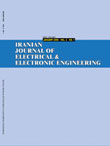فهرست مطالب

Iranian Journal of Electrical and Electronic Engineering
Volume:12 Issue: 3, Sep 2016
- تاریخ انتشار: 1395/07/07
- تعداد عناوین: 6
-
-
Pages 177-186One of the instruments for determination of position used in several applications is the Global Positioning System (GPS). With a cheap GPS receiver, we can easily find the approximate position of an object. Accuracy estimation depends on some parameters such as dilution of precision, atmospheric error, receiver noise, and multipath. In this study, position accuracy with GPS receiver is classified in three classes. Nine classification methods are utilized and compared. Finally, a new method is selected for classification. Results are verified with experimental data. Success rate for classificationis approximately 84%.Keywords: GPS, DOP, classification, error
-
Pages 187-196Physical-layer network coding (PLNC) has the ability to drastically improve the throughput of multi-source wireless communication systems. In this paper, we focus on the problem of channel tracking in a Decode-and-Forward (DF) OFDM PLNC system. We proposed a Kalman Filter-based algorithm for tracking the frequency/time fading channel in this system. Tracking of the channel is performed in the time domain while data detection is implemented in the frequency domain. As an important advantage, this approach does not need for training of some subcarriers in every OFDM symbols and this, results in higher throughput, compared to other methods. High accuracy, no phase ambiguity, and stability in fast fading conditions are some other advantages of this approach.Keywords: Physical Layer Network Coding, Decode, and, forward, Orthogonal Frequency Division Multiplexing (OFDM), channel tracking, Kalman Filter
-
Pages 197-205Automatic recognition of speech emotional states in noisy conditions has become an important research topic in the emotional speech recognition area, in recent years. This paper considers the recognition of emotional states via speech in real environments. For this task, we employ the power normalized cepstral coefficients (PNCC) in a speech emotion recognition system. We investigate its performance in emotion recognition using clean and noisy speech materials and compare it with the performances of the well-known MFCC, LPCC, RASTA-PLP, and also TEMFCC features. Speech samples are extracted from the Berlin emotional speech database (Emo DB) and Persian emotional speech database (Persian ESD) which are corrupted with 4 different noise types under various SNR levels. The experiments are conducted in clean train/noisy test scenarios to simulate practical conditions with noise sources. Simulation results show that higher recognition rates are achieved for PNCC as compared with the conventional features under noisy conditions.Keywords: Noisy Acoustic Condition, Noise Robust Auditory Feature, Power Normalized Cepstral Coefficients (PNCC), Speech Emotion Recognition
-
Pages 206-221In this paper, several optimum structures of a cascaded multilevel inverter is proposed. This optimization is based on generation a constant number of output voltage levels by using minimum number of power switches or dc voltage sources or minimum amount of blocked voltage by power switches. In addition, the optimum structure for a constant number of dc voltage sources by using minimum number of power switches is obtained. In these optimizations, all of the presented algorithms to generate a desired sinosuidal waveform of the cascaded multilevel inverter are considered. Then, the proposed optimum topologies are compared with several conventional cascaded multilevel invereters that have been presented in literature. These comparisons are from the number of required power switches, dc voltag sources, variabilty the magnitude of dc voltage source and the value of blocked voltage by switches points of view. The conduction and switching losses of the proposed topologies are calculated. In addition, a 49-level cascaded inverter based on the proposed optimum topologies is designed. Moreover, the designed topologies are compared to each other from the amount of blocked voltage by swithes, the maximum magnitude of output voltage levels and the number of required power electronic devices such as power switches, driver circuits and diodes points of view. Finally, the ability of the optimium topology in generation all voltage levels (even and odd) by using minimum number of power switches is reconfirmed thruogh PSCAD/EMTDC simulation and experimental results on a 49-level inverter.Keywords: Multilevel inverter, cascaded multilvel inverter, basic unit, optimum structures, power electronic devices
-
Pages 222-229The article presents the transients analysis of the substation grounding systems and transmission line tower footing resistances which can affect to the back-flashover (BF) or overvoltage across insulator chain in an HV power systems by using EMTP-RV software. The related transient modeling of the grounding systems is based on a transmission line (TL) model with considering the soil ionization. In addition, different configuration of grounding system have been simulated to calculated the BF, including number of vertical grounding rod, length of rod, point of lightning current injection into the grounding grid and using two depth design of grounding system where the surface of substation under consideration is very small orit is necessary to bury the grounding grid in the rocky media, occasionally. The simulation results have shown that how the mentioned parameters can considerably affect inception of BF, and suitable design of grounding system can reduce damages caused by lightning.Keywords: Back, flashover (BF), Grounding system, Transient modeling
-
Pages 230-239In this paper, impacts of day-ahead market pricing on behavior of producers and consumers in option and day-ahead markets and on option pricing are studied. To this end, two comprehensive equilibrium models for joint put option and day-ahead markets under pay-as-bid and uniform pricing in day-ahead market are presented, respectively. Interaction between put option and day-ahead markets, uncertainty in fuel price, day-ahead market pricing, and elasticity of consumers to strike price, premium price, and day-ahead price are taken into account in these models. By applying the presented models to a test system impact of day-ahead market pricing on equilibrium of joint put option and day-ahead markets are studied.Keywords: Equilibrium of joint put option, day, ahead markets, Option market modeling, Uniform pricing, Pay, as, bid pricing, Put option pricing, Supply function competition

